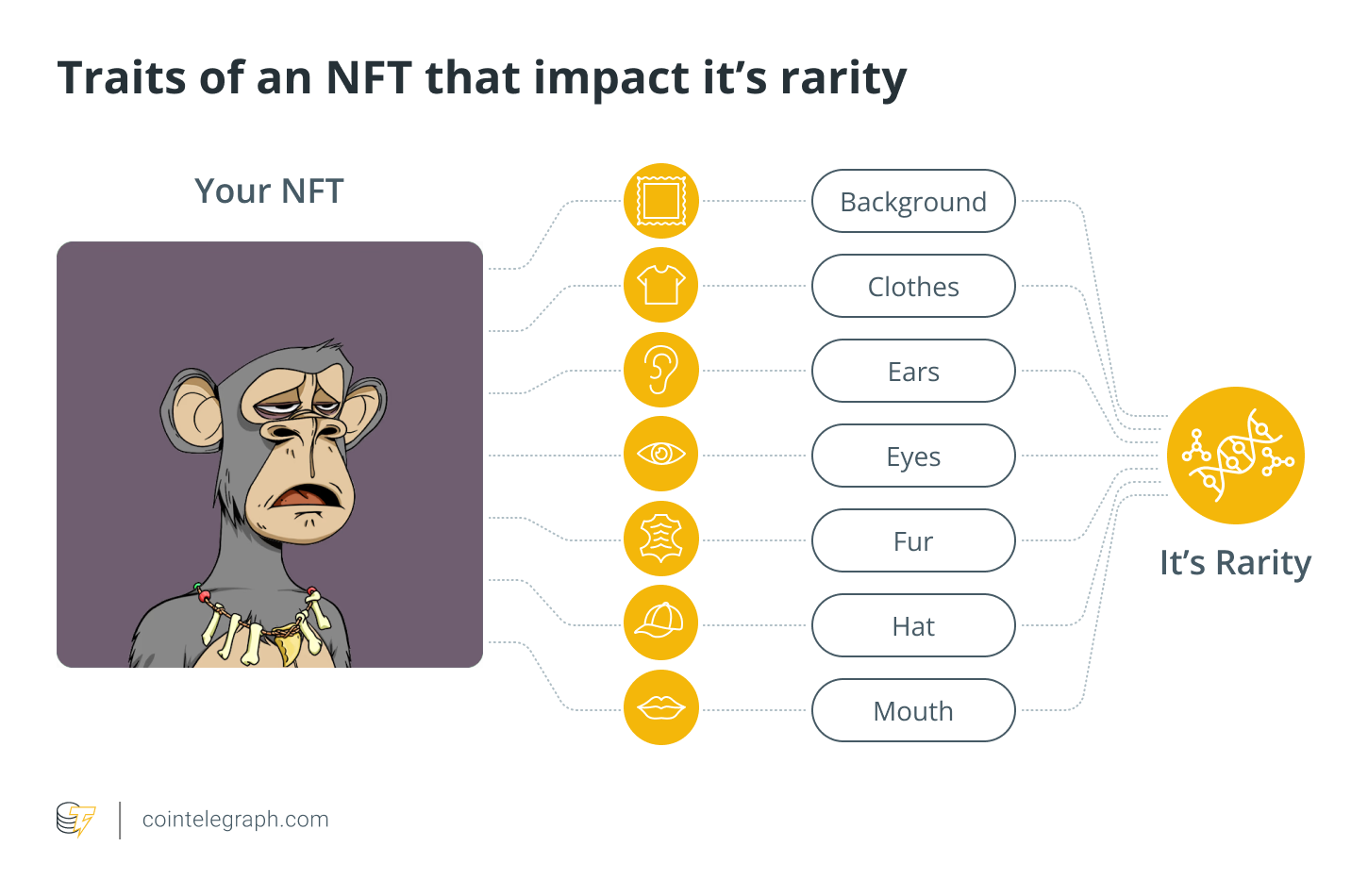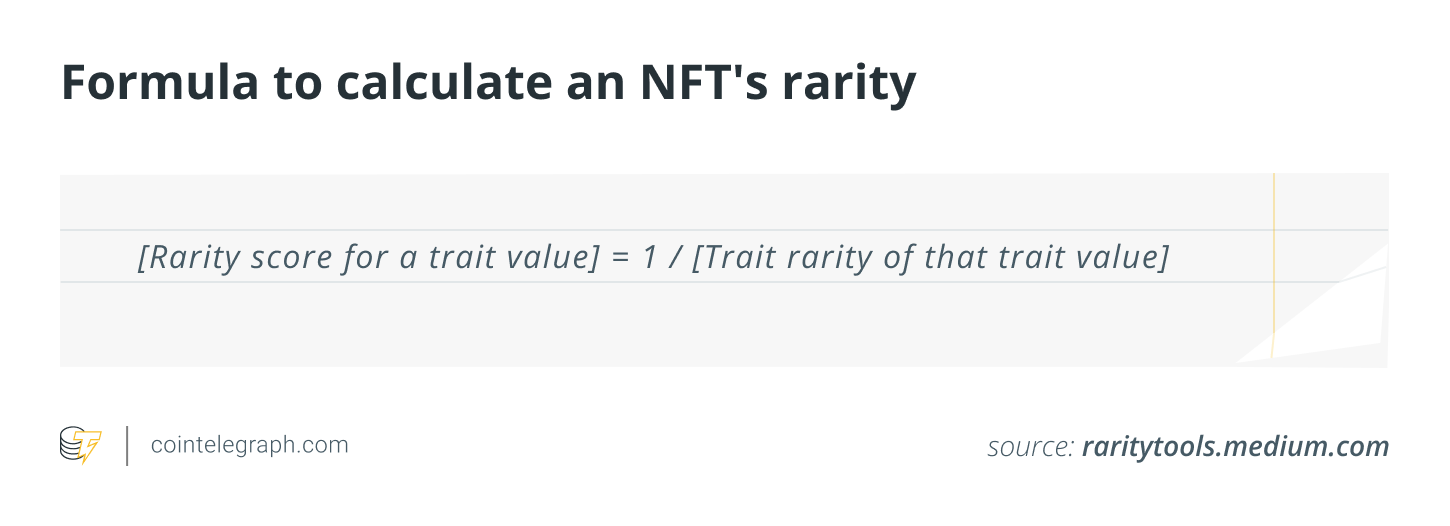NFT
An NFT’s rarity plays a role in its perceived cultural and artistic significance. For example, an nonfungible token (NFT) that is the only one of its kind and possesses significant cultural or historical value may be considered a rare and must-have artifact. But why is NFT rarity important?
NFT rarity is important because the market worth and appeal of an NFT can be significantly influenced by the nonfungible token’s rarity, which can also influence its resale value. Moreover, NFT collectors frequently look for unusual and distinctive nonfungible tokens to add to their collections.
Nonetheless, it is crucial to remember that an NFT’s worth or relevance is not necessarily determined by its rarity alone. Other elements that may affect the value and appeal of nonfungible tokens to collectors include the caliber of the artwork, the reputation of the artist and the cultural or historical relevance of the piece.
This article will discuss the concept of NFT rarity, what determines NFT rarity and common techniques for calculating NFT rarity rankings.
NFT rarity, explained
NFT rarity refers to the uniqueness or scarcity of a particular nonfungible token in a collection. The overall number of nonfungible tokens in a collection, the number of copies of a certain nonfungible token in a collection and the unique qualities or traits of a particular NFT are all factors that affect nonfungible token rarity.
For instance, certain NFT collections could contain a small total number of NFTs, which can increase the rarity of each nonfungible token in a given collection. Some collections might have a lot of NFTs, but a specific nonfungible token might be uncommon because it has distinctive qualities, such as a particular color scheme, animation or sound effect.

The value of NFT collectibles can be significantly impacted by its rarity. Due to their increased value and demand from collectors, the price of rare NFTs may rise on NFT marketplaces. Some NFT projects have even created algorithms to figure out the rarity of specific NFTs within a collection, which can provide buyers and sellers with more knowledge when figuring out the worth of an NFT.
What is an NFT rarity checker?
An NFT rarity checker is a tool or service that allows users to assess the rarity of a nonfungible token, whose value is frequently based on its scarcity, rarity and uniqueness.
To determine an NFT’s rarity, nonfungible token rarity calculators examine a variety of features of the nonfungible token, including its properties, metadata and characteristics. An NFT rarity checker, for instance, might evaluate the color scheme, pixel density or other visual characteristics of an nonfungible token image to ascertain its rarity.
As an alternative, an NFT rarity checker might assess the demand for a certain nonfungible token or the quantity of copies of that NFT that are currently on the blockchain to determine how rare it is.
Here are some common steps that an NFT rarity calculator may follow to determine the rarity of a nonfungible token:
- Identify the rarity: The calculator must first determine the precise NFT that is being assessed. This may involve entering the token ID for the nonfungible token or other identifying information.
- Collect data: The calculator then gathers information about the NFT, such as its characteristics, sales performance and blockchain data.
- Analyze attributes: The calculator may evaluate the NFT’s visual and other properties, including its pixel density and other distinguishing features.
- Assess rarity: Based on the information gathered and the examination of the nonfungible token’s characteristics, the calculator can then utilize algorithms to determine the NFT’s rarity. The NFT may be compared to other nonfungible tokens in the same collection; sales information and market trends may be examined.
- Provide results: The calculator also offers a numerical evaluation of the NFT’s rarity, which is frequently presented as a score or rating. Buyers and sellers can use this information to estimate the NFT’s value.
However, the rarity and value of an NFT can also be influenced by other factors, such as the present market conditions and buyer and seller sentiments, so it is crucial to keep in mind that these calculators are not ideal.
Related: How to add unlockable content to your NFT collection
How do you determine NFT rarity?
Determining NFT rarity can involve various factors depending on the specific nonfungible token and the attributes that it possesses. One of the key elements that can indicate an NFT’s uniqueness is its scarcity. NFT collections are more likely to be rare and valuable if there are fewer copies of them than if there are many. By counting all of the copies of a nonfungible token that are present on the blockchain, it is possible to estimate its rarity.
Nonfungible tokens can have a number of characteristics that contribute to their rarity. An NFT might, for instance, stand out due to its distinct color scheme, an uncommon combination of characteristics or a particular theme or subject matter. These characteristics can be examined and compared to those of other nonfungible tokens in the same category to determine how rare an NFT is.
Popularity and demand can also affect NFT rarity. That said, NFT collections are more likely to be rare and expensive if there is a great demand for them. Sales information, social media mentions and other popularity indicators can be used to determine this.
An NFT’s history or provenance may have an effect on its rarity. A nonfungible token may be rarer and more expensive than other NFTs if it has a distinctive past, such as having once belonged to a celebrity or being featured in a well-known meme.
How are NFT rarity rankings calculated?
Depending on the particular NFT collectibles, the number of editions or copies that exist within that collection and the demand for that particular NFT within the marketplace, there are numerous approaches to generating nonfungible token rarity rankings.
Typically, the formula involves giving each quality or trait a numerical value before summing them to determine the rarity score. However, depending on the NFT platform or market, the precise formula may change. To calculate rarity scores, some platforms may also use external data sources or machine learning algorithms.

For instance, platforms, such as Rarity.tools and Nansen employ algorithms to examine the characteristics and properties of each NFT contained in a collection and calculate the rarity score.
In general, here are a few common techniques to determine NFT rarity rankings:
- Algorithmic scoring: One method for determining NFT rarity rankings is to employ an algorithmic scoring system that rates each nonfungible token according to a number of criteria, including rarity, qualities, popularity and provenance. The rarity of NFTs can be ranked using these metrics.
- Comparative analysis: In this method, each NFT is compared to other nonfungible tokens from the same collection or category. This analysis can provide a qualitative rating of each NFT’s rarity by taking into account variables, such as scarcity, qualities, sales history and market trends.
- Data analysis: Data analysis, such as sales data or social media mentions, can also be used to determine nonfungible token rarity rankings. This study can reveal what NFTs are the most well-liked and in-demand, and it can be used to rank the rarest and most expensive nonfungible tokens.
- Community feedback: The opinions of NFT collectors, creators and specialists can have an impact on the rarity rankings of nonfungible tokens. The rarest and most expensive nonfungible tokens in a certain category or collection can be ranked using an amalgamation of these ratings.
Related: NFT investment: A beginner’s guide to the risks and returns of NFTs
Is a high rarity score good for an NFT?
Do you wonder what a good NFT score is or if a high rarity score means the scarcest nonfungible token? The answer is that there is no one-size-fits-all approach to what constitutes a “good” NFT rarity score, as the score will depend on a variety of factors, such as the specific nonfungible token collection, the attributes or traits being measured and the prevailing market conditions.
Furthermore, even if a high rarity score can be seen favorably for an NFT, rarity scores are frequently arbitrary and susceptible to a variety of influences, as mentioned above. Additionally, a high rarity score does not always imply a significant value or resale price because other elements, such as the fame of the artist and the cultural or historical relevance of the nonfungible token, might also come into play.
As a result, while a high rarity score might be a reliable indicator of a nonfungible token’s value and originality, it is essential to take other aspects into account when determining the value of a nonfungible token.


